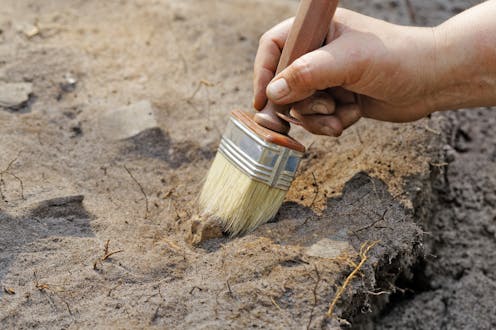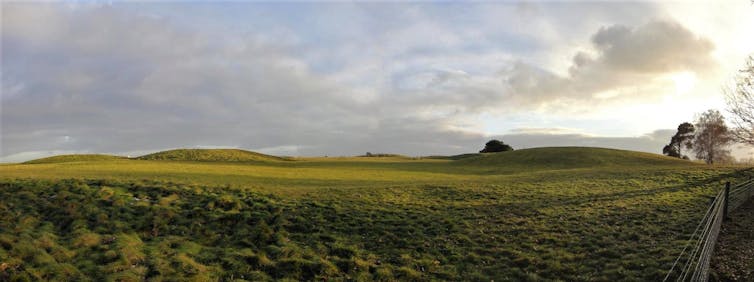
Following the collapse of the Roman Empire in the early fifth century, groups from northwest Europe made their way to British shores. Germanic peoples settled in what is now England between the fifth and seventh centuries AD.
The traditions around death and burial they brought with them provide us with a snapshot of the lives and deaths of people in these communities. Burials can also offer information about a frequently overlooked group: children.
Due to a lack of written records, our knowledge about the people who lived in early medieval England often comes from the excavation of burial sites. Well-known examples include the Sutton Hoo ship burial in Suffolk and the Prittlewell chamber grave in Essex.

These uncovered highly elaborate artefacts, such as the Sutton Hoo helmet. However, burials like these are rare, and give us a skewed view of history. Very few people were offered such ostentatious funerals.
There are two types of burial from this period. Cremated bone deposits are found in buried pottery urns: the dead were cremated on an open pyre, accompanied by objects and animal offerings. In some cases, additional unburned items, such as bone combs, were added to the urn before burial.
The other type of burial was a more straightforward affair. The deceased was buried in a grave with artefacts of relevance to their identity in life. This is known as “inhumation”.
Clues to the past
The objects buried with people provide important clues about their lives. Grave provisions from early medieval burials include jewellery and combs, knives and pottery vessels. They can also contain animal bones belonging to a range of species, such as horses, cattle, pigs, dogs, birds, and bears.
Regardless of the funerary rite bestowed on children, there are similarities in the objects that were bestowed and buried with these individuals. Analyses have shown that infants and children under 12 years of age were less likely to be buried with animal offerings and, where they were, a narrow range of species were gifted to the young individuals. Children were most likely to be gifted sheep or goat, or pig offerings at the funeral.
They were also more likely to be found with a narrower range of artefacts, including beads, rings, combs, knives and spindle whorls, than older members of the community. In addition to the items buried with children, adult males were sometimes found with weapons, such as swords, shields, and spearheads, while adult females were typically buried with jewellery, including different types of brooches.

The more restricted range of objects found with children possibly indicates their different social status, roles within the household, and identity in life.
Interestingly, the cremated remains of infants and children were buried in shorter urns, while their contemporaries from inhumation cemeteries were interred with shorter knives than adolescents and adults. This potentially suggests that people were given longer knives or taller pots as they passed through key stages of life.
Adolescence was a crucial time in a young person’s life as they took on new roles and responsibilities. Some of these roles are likely to have involved the management of livestock and participation in other economic activities, such as crafting.
This would marry up with a law written in the seventh century AD which states that individuals over ten years of age were old enough to manage their family’s land and property. Therefore, increased interaction with animals and greater economic contribution may have warranted the endowment of animals or a wider range of objects at the funeral.
Even though children were socially distinct from older individuals, they were clearly cared for. They were included in household burial plots among groups who practised cremation.
Furthermore, when children were sometimes buried alongside adults in what is known as the “multiple burial rite”. The most frequent demographic pairing when this took place was of an infant or child and an adult. But we cannot assume that individuals found in multiple burials were blood relatives. Instead, individuals may have been buried together as they shared social attributes, such as ideological beliefs, or kin ties.
Archaeologist Nick Stoodley has suggested that the caring responsibilities of adults extended to the afterlife. This could explain why this demographic pairing is most common.
Looking to the future
Even though researchers are starting to pay more attention to children from early medieval contexts, the development of osteological techniques – which are used to analyse skeletal remains – and advances in analytical methods will allow us to learn more about the youngest members of early medieval society.
Organisations such as The Society for the Study of Childhood in the Past (SSCIP) champion research that focuses specifically on children in the past, and the important roles they played in society.
The promotion of archaeological research focused on children will not only lead to a more rounded understanding of children from early medieval England, but also of young people from other points in history.
What did you think of this article?
Great | Good | Okay | Weak
Kirsty Squires does not work for, consult, own shares in or receive funding from any company or organisation that would benefit from this article, and has disclosed no relevant affiliations beyond their academic appointment.
This article was originally published on The Conversation. Read the original article.







